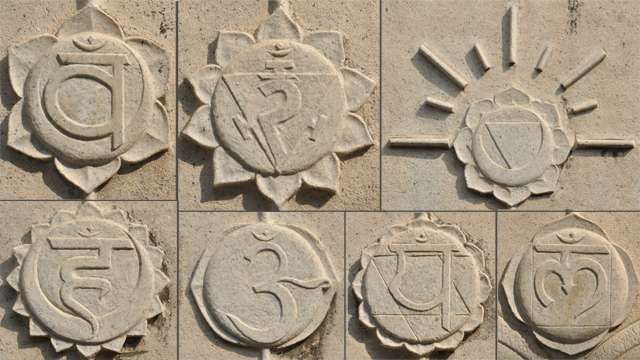
Sadhguru: There is too much of “chakra talk” going on everywhere. Especially in the West, wherever you go, there are “wheel alignment centers” where they claim to “align” your seven chakras. From Yoga studios to chiropractics, everyone is talking about it these days. That has become a fad. But though everyone only talks about seven chakras, there are actually 114 chakras in the body.
What Are the 7 Chakras?
You can see them as 114 junctions or confluences of nadis. The nadis are the channels of prana in the energy body. These junctions are always in the form of triangles. They are called chakras because they embody movement from one dimension to another, and the word “chakra” means “wheel” or “circle.” But they are actually triangles.
It is these seven dimensions which are generally being referred to as the 7 chakras, which are in turn the basis for the seven schools of yoga.
Out of these 114 chakras, two are outside the physical body. Of the remaining 112, only 108 can actually be worked upon, the remaining four just flower as a consequence. The number 108 has manifested in the human system because it is a significant number in the making of the solar system. The distance between the earth and the sun is 108 times the diameter of the sun. The distance between the earth and the moon is 108 times the diameter of the moon. The diameter of the sun is 108 times the diameter of the earth. And hence, 108 is significant in various spiritual practices.
Out of these 114 chakras, two are outside the physical body. Of the remaining 112, only 108 can actually be worked upon, the remaining four just flower as a consequence.
These 112 chakras arrange themselves into seven dimensions, with sixteen aspects in each dimension. Instead of going into 112, which is too much of a number for a lot of people, generally, only seven were spoken about because of these seven categories or seven dimensions. It is these seven dimensions which are generally being referred to as the seven chakras, which are, in turn, the basis for the seven schools of Yoga.
From 112 To 7 Chakras
For a human being to live a full-fledged physical and social life, he needs only twenty-one chakras in his body to be active. These twenty-one chakras are also connected with the number seven. Because of the three dimensions of energy of Pingala, Ida and Sushumna, there are seven sets, each with three chakras functioning as one. So if twenty-one chakras are functioning, physically, psychologically and emotionally, you will be complete. But energy-wise, you will be a cripple.
For a human being to live a full-fledged physical and social life, he needs only twenty-one chakras in his body to be active. These 21 chakras are also connected with the number seven.
If other dimensions have to become a living reality, the rest of the chakras have to be activated. Intelligence has to be empowered by energy. Otherwise, a sleeping intelligence is as good as being non-existent. A computer which cannot be turned on is as good as a slab of stone. It is the same with the human system, too. This is a super computer, but most people are keeping it functioning only on the level of survival.
If twenty-one chakras are functioning, physically, psychologically and emotionally, you will be complete. But energy-wise, you will be a cripple.
If something more of what the human system is capable of needs to happen, it needs an activation. Hatha Yoga is that discipline which activates the whole system. Unfortunately, people think Hatha Yoga is an exercise or some kind of health regimen. Yoga never focuses on curing something. We only look at how this physical system can be made full-fledged. If it is full-fledged, everything will be fine. It will activate something that will lead to a curative process by itself anyway.
The Location And Names Of The 7 Chakras
The seven fundamental chakras are known as muladhara, which is located at the perineum, the space between the anal outlet and the genital organ; swadhisthana, which is just above the genital organ; manipuraka, which is just below the navel; anahata, which is just beneath where the rib cage meets; vishuddhi, which is at the pit of the throat; ajna, which is between the eyebrows; and sahasrara, also known as brahmarandra, which is at the top of the head, where when a child is born, there is a soft spot.
Get weekly updates on the latest blogs via newsletters right in your mailbox.
Chakras have more than one dimension to them. One dimension is their physical existence, but they also have a spiritual dimension.
We can speak in terms of lower and higher energy centers, but such language is often and too easily misunderstood. It is like comparing the foundation of a building to the roof. The roof is not superior to the foundation. The foundation of the building is more basic to the building than the roof. The quality, life span, stability and security of the building depends to a large extent on the foundation rather than the roof. But in terms of language, the roof is higher, and the foundation is lower.
If your energies are dominant in muladhara, then food and sleep will be the most dominant factors in your life.
If your energies are dominant in muladhara, then food and sleep will be the most dominant factors in your life. Chakras have more than one dimension to them. One dimension is their physical existence, but they also have a spiritual dimension. This means that they can be completely transformed. For example, if you bring the right kind of awareness, the same muladhara that craves food and sleep, can become absolutely free from the process of food and sleep.
Subtler Aspects Of The 7 Chakras In The Body
These chakras have a manifestation in the body. And they also have a subtler manifestation. These manifestations are called kshetras. Kshetra means a place where someone resides. You may be in your office, but your residence is somewhere else. Just like that, there are kshetras that are external ones, called bahya kshetras, and there are internal ones called antar kshetras. There is a home and a holiday home!
These chakras have a manifestation in the body. And they also have a subtler manifestation. These manifestations are called kshetras.
When you are at home, you will be one way. Generally, the mundane occupies your time and life. Most of your time goes in cooking, cleaning, maintenance and fixing up things. When you go to your holiday home, even though there is cooking, cleaning and all the other stuff, the mundane does not occupy the whole of you. It is a more exuberant existence.
A holiday home in the mountain is a more exuberant existence, though it may be physically more taxing than being at home. Being at home is easier. Many people have given up and just stay at home because it is easier. But the reason why you went to another home away from home is you still want to know the coziness of a home, you do not want to stay in a hotel, but you want a more exuberant existence. The Creator provided for all that. You can be in the antar kshetra, not so vibrant and just sleeping, or you can be in the bahya kshetra. Any time you want to go back home, it is not a problem, you can always step back.
The second chakra is svadhisthana. If your energies are dominant in svadhisthana, pleasures will be most dominant in your life.
Chakras have more than one dimension to them. One dimension is their physical existence, but they also have a spiritual dimension. This means that they can be completely transformed. For example, if your energies are dominant in muladhara, then food and sleep will be the most dominant factors in your life. But if you bring the right kind of awareness, the same muladhara that craves food and sleep, can become absolutely free from the process of food and sleep.
The second chakra is swadhisthana. If your energies are dominant in swadhisthana, pleasures will be most dominant in your life – you seek pleasures, you enjoy the physical reality in so many ways. If your energies are dominant in manipuraka, you are a doer; you can do many things in the world. If your energies are dominant in anahata, you are a very creative person. If your energies are dominant in vishuddhi, you become very powerful. If your energies are dominant in ajna or if you attain to ajna, then intellectually, you are realized. Intellectual realization gives you peace. Experientially it has not happened yet but intellectual realization has come to you, which brings you to a certain state of peace and stability within yourself irrespective of what is happening outside of you. And once your energies hit sahasrara, you are simply ecstatic like crazy! There is no external stimulant, there is simply no reason, but you are ecstatic simply because energies have touched a certain peak.
7 Chakras, 7 Levels Of Intensity
Fundamentally, any spiritual path can be described as a journey from the muladhara to the sahasrara. This journey is an evolution from one dimension to another; these are just seven different levels of intensity.
Fundamentally, any spiritual path can be described as a journey from the muladhara to the sahasrara.
To move your energies from muladhara to ajna, there are many spiritual processes and several ways, but to move from ajna to sahasrara, there is no path. There is no particular way. One has to either jump or fall into a bottomless pit. This is called “falling upward.”
In Yoga, they say unless you are willing to fall upward, you will not get there. This is why so many so-called spiritual people have come to the conclusion that peace is the highest possibility – because they got stuck in ajna. Peace is not the highest possibility. You can become ecstatic, so ecstatic that the whole world becomes a big joke in your understanding and experience. Everything that is dead serious for everyone is just a joke for you.
To move your energies from muladhara to ajna, there are many spiritual processes and several ways, but to move from ajna to sahasrara, there is no path.
But people come and stop at the ajna for a long time, just to make up their mind to jump. This is why in the spiritual traditions, so much stress was always laid on the Guru-shishya relationship – the master-disciple relationship. This is simply because if you have to take this jump, you need deep trust in the Guru. 99.9% of the people need trust, otherwise they cannot jump. This is the reason why so much stress is laid on this relationship, because without trust, one will never take that jump.
Discernment And Intellect
These seven chakras or seven dimensions are not a philosophy, but a little bit of classification. Fundamentally, any classification of life is wrong, but this classification is done for the sake of understanding. The seven chakras are not to be understood as seven segments. Life is happening as one big whole. But the intellect needs classification. Without classification, your intellect cannot perceive. The nature of the intellect is to discern. Without the ability to discern, your intellect is a useless piece of machinery.
Enlightenment means that you are lit from inside, so you cannot see darkness anywhere.
Discernment is a very important instrument to survive in the world, but it is not at all a good thing if you want to swallow the cosmos, which means you want the cosmos to become a part of you or to disappear into you. If you are discerning, which planet would you like to leave out? Discernment is about what you want and what you do not want, what you like and what you do not like; what is good and what is bad; what is high and what is low; what is god and what is devil.
Enlightenment is when you light up everything in such a way that everything looks the same to you. You do not want to discern anything. Light and darkness are the same experience to you. There is no distinction for you. Enlightenment means that you are lit from inside, so you cannot see darkness anywhere.
Beyond Color
We are talking about a dimensionless dimension, but for the sake of the intellect, we are categorizing. You should not start taking positions, in the sense of “I’m the Anahata kind” or “I’m the Vishuddhi kind,” like people say, “I’m a coffee person” or “I’m a tea person.” Or when they wake up in the morning, they say, “I’m a morning person.” This is not about getting identified. If you want to do specific things, you can discern different qualities. But if you want to know the very nature of existence, there is a dimension called vairagya or vairaga. “Vai” means beyond, and “raga” means color. Something that is beyond color is colorless. The word “colorless” in English has negative connotations, such as being lifeless or lacking vibrance, but vairagya is not colorless in that sense.
We are talking about colorless as being beyond color. That which has no color is transparent. Transparency enables you to see. It is colorless air that sustains you. Suppose the air turned blue, you would not be able to see anymore. You may like the blue color in the air for some time, but then you would want to clear the blue and see again. Becoming colorless, or being beyond color, means to have a clear vision. Your vision is not clouded by colors. There are many things which are referred to by their color – rivers for example, such as the Blue Nile, the Yellow River, or the Red River. This does not mean the water as such is blue, yellow, or red – it is the soil that it carries that makes it appear as being of a certain color.
If you are beyond color, you fit into any place perfectly well, because you yourself are colorless, without attributes. Now, if there is a blue background, you turn blue; if there is a red background, you turn red. You will not be felt anywhere as a resistance. You are absolutely merging with whatever is there at any given moment. So we are talking about seven dimensions that are like seven colors. There is nothing wrong with refracting the light, but if you are in refracted light all the time, you will have a distorted vision of life.
The 7 Chakras – subject to much myth & lore – demystified by one with total mastery of the energy system. Watch the exciting series, Chakras, only on Sadhguru Exclusive. Subscribe now.





